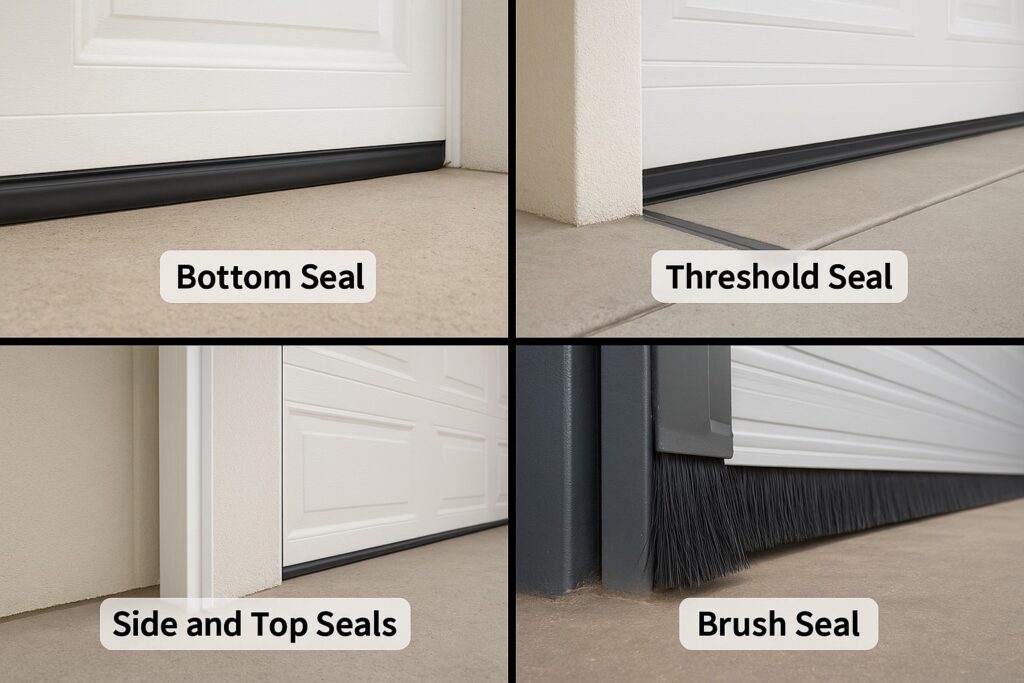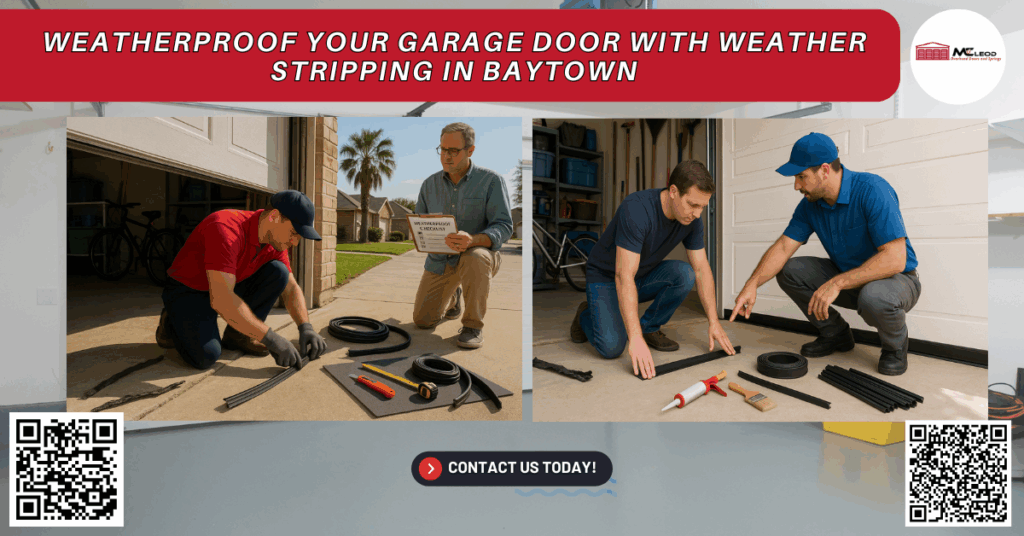Keep the Baytown Storms Out of Your Garage
Recently, a local Baytown homeowner reached out to our team after noticing that water and dirt were frequently entering their garage after each rainfall. They had invested in a brand-new garage door but failed to include proper weather stripping during installation. As a result, cold air drafts, water, and even insects were invading their space. After our technicians installed high-quality garage door weather stripping along the bottom seal and side jambs, the problem was resolved almost instantly. The homeowner was amazed at the big difference that this simple solution made in maintaining a clean, dry, and energy-efficient garage.
Baytown receives over 55 inches of rain annually, and when combined with the city’s humid climate and occasional strong winds reaching over 40 km/h, homes are frequently exposed to moisture, temperature fluctuations, and even pests. For many homeowners, the garage is not only a place to park vehicles but also a storage space, workshop, or entry point into the house. Without proper weatherproofing, this area becomes vulnerable to water damage, temperature loss, and rising energy bills.
Garage door weather stripping is more than just an accessory. It is a key element in ensuring the protection of your home, preserving your garage door’s structural integrity, and promoting energy efficiency year-round. In this comprehensive guide, we will walk you through everything you need to know about garage door weather stripping in Baytown, helping you make informed decisions and avoid common mistakes.
Why Weather Stripping Matters in Baytown
Baytown’s coastal proximity makes it susceptible to high humidity, heavy rainfall, and sudden climate changes. These environmental factors can significantly affect the performance and longevity of your garage door. Without a proper seal, your garage becomes an easy entry point for water, debris, dust, pests, and outside air. This compromises the indoor climate and results in increased wear and tear on your garage components.
The Purpose of Garage Door Weather Stripping
Garage door weather stripping consists of specialized materials, such as rubber, vinyl, brush, or foam, that create a tight seal around the edges of the garage door. These materials are carefully installed along the top seal, side jambs, and bottom seal of the door to prevent outside elements from penetrating the interior space. This process helps establish an airtight barrier, offering better insulation and extending the life of your garage door and related hardware.
Problems Prevented by Weather Stripping
By investing in professional installation of weatherstripping, homeowners can prevent a wide range of problems, including:
- Water Damage: Moisture can seep in through gaps around the garage door, damaging stored belongings and promoting mold growth.
- Drafts and Energy Loss: Cold air or hot air can enter or escape through unsealed areas, leading to inconsistent indoor temperatures and increased energy costs.
- Rodents and Pests: Gaps in the door frame invite pests, including rodents and insects, to enter the space and nest.
- Dust and Dirt: Wind-blown particles can collect inside, creating additional cleaning and maintenance tasks.
- Noise Pollution: A properly sealed door helps reduce outside noise and insulates against vibrations caused by operation.

Common Types of Garage Door Weather Stripping
Understanding the different types of weather stripping is crucial for choosing the right material for your specific garage door and climate. Each material and design serves a specific function and offers unique benefits.
Bottom Seals
The bottom seal is the first line of defense against outdoor elements. These seals are installed along the bottom edge of the door and compress against the concrete floor to block water, dirt, and air. Popular bottom seal types include:
- Rubber Bulb Seals: Flexible and round in shape, these seals compress well on uneven surfaces.
- T-style and Beaded Seals: These seals are designed to fit snugly into metal retainers attached to the bottom of the door.
- Threshold Seals: Unlike other bottom seals, these are installed on the garage floor itself, creating a raised barrier to block flooding and debris.
Side and Top Seals
These seals are made from vinyl or rubber and are installed along the door jambs and head jamb to seal the perimeter. They help maintain a tight seal that reduces air and water infiltration. This installation is essential for both residential and commercial garage doors.
Brush Seals
Brush seals are often used in commercial settings where durability and flexibility are required. These seals feature dense nylon or polypropylene bristles that conform to irregular surfaces, making them ideal for loading docks, warehouse doors, and other high-use applications.

Signs That You Need New Weather Stripping
Garage door weather stripping does not last forever. Exposure to the sun, rain, and changing temperatures can cause seals to wear down, crack, or become brittle over time. Here are common indicators that it may be time for replacement:
- Visible Gaps: Light shining through when the door is closed indicates a lack of airtight protection.
- Cracks or Peeling: Worn rubber or vinyl materials often crack, peel, or harden with age.
- Water or Drafts: If you notice puddles, condensation, or fluctuating temperatures in your garage, your weather stripping may have failed.
- Increased Energy Bills: Escaping warm or cool air forces your HVAC system to work harder, leading to higher utility costs.
We recommend homeowners inspect their garage door weather seals at least twice per year, ideally before the rainy season and after the summer heat.
How to Install Weather Stripping on Your Garage Door
While many homeowners attempt DIY weatherproofing, precise measurements and proper alignment are crucial for effective results. Here is a step-by-step guide to understanding the installation process:
Tools and Materials Needed
- Measuring tape
- Utility knife
- Galvanized nails or screws
- Drill or hammer
- Weather stripping material (rubber, vinyl, brush, or foam)
Step-by-Step Guide
- Measure the Door: Measure the width and height of the door, including the top and side jambs.
- Remove Old Material: Strip away old seals and clean the door surfaces thoroughly to remove dust and debris.
- Cut the New Stripping: Trim your weather stripping to match the measured lengths using a sharp utility knife.
- Attach Bottom Seal: Slide or nail the bottom seal into its retainer or install a new straight holder for added support.
- Install Top and Side Seals: Secure these using galvanized nails or screws, ensuring a snug fit along all edges.
- Test the Seal: Close the door and look for any visible light or air movement. Adjust as needed for a proper seal.
Even a slight misalignment can result in ongoing air leaks and reduced efficiency, so professional installation is recommended for best results.
Key Benefits of Garage Door Weather Stripping
Installing quality weather stripping around your garage door brings multiple benefits that enhance the overall comfort, cleanliness, and value of your home.
Enhanced Energy Efficiency
Proper weatherstripping prevents drafts, minimizes air leaks, and maintains stable indoor temperatures. In Baytown’s hot and humid climate, this helps reduce air conditioning strain, lowers energy bills, and contributes to an energy-efficient home environment.
Moisture and Pest Protection
Water intrusion can lead to costly water damage, rust, and corrosion of tools or stored belongings. A tight seal also prevents unwanted pests like ants, spiders, and rodents from entering your garage.
Improved Comfort and Air Quality
A sealed garage provides a cleaner, more comfortable space for hobbies, storage, or laundry. It also reduces the intrusion of outdoor allergens, pollen, and dust, improving air quality within your home.
Reduced Noise and Vibration
Weather stripping softens the closing impact of the garage door and reduces outside noise, especially beneficial if your garage is attached to living spaces.
Long-Term Garage Door Protection
By limiting exposure to moisture and dust, garage door weather stripping extends the life of your springs, opener, rollers, and other key components. This results in fewer repairs and more years of reliable service.
Weather Stripping for Commercial Garage Doors
Commercial buildings in Baytown face the same environmental challenges as residential homes, but often on a larger scale. Warehouses, repair shops, and storage facilities benefit greatly from professional-grade weatherproofing solutions.
Advantages for Commercial Properties
- Inventory Protection: Prevent water damage, corrosion, and temperature fluctuations that can affect equipment and goods.
- Energy Cost Reduction: Climate-controlled commercial spaces experience significant savings when insulated and sealed correctly.
- Safety and Hygiene: Sealing prevents standing water and mud from accumulating near loading zones, reducing slip hazards and maintaining sanitary conditions.
McLeod Overhead Doors and Springs offers specialized commercial weatherproofing services, including brushseal kits, PVC material seals, and dock leveler weather stripping customized for heavy-duty applications.
Local Climate Conditions That Demand Proper Sealing
Baytown’s unique weather patterns make it essential to have properly installed and maintained weather stripping. Here are key environmental factors that make a tight seal necessary:
- Realfeel®28° Realfeel Shade™26° Temperatures: Humid, wet days intensify the need for insulation and moisture control.
- Storms with Wind Gusts Exceeding 60 km/h: Strong winds can blow water and dust into the garage without adequate barriers.
- High Rainfall and Flood Risk: The Gulf Coast area sees significant downpours, increasing the need for a threshold seal to prevent flooding.
- Extreme Temperatures in Summer and Winter: Maintaining internal temperature is critical for both comfort and energy savings.
These challenges highlight the importance of protecting your garage space with premium garage door weather solutions that meet Baytown’s specific climate demands.
Maintenance Tips for Longevity
Weather stripping requires periodic attention to remain effective. Follow these upkeep tips to extend the life of your garage door weather materials:
- Perform Visual Inspections: Check for cracks, gaps, or discoloration twice per year.
- Clean Regularly: Remove dirt and grime using mild soap and water to preserve flexibility.
- Avoid Harsh Chemicals: Strong cleaners can degrade rubber and vinyl over time.
- Replace as Needed: Replace worn weather stripping immediately to maintain a consistent seal.
- Lubricate Hardware: Ensure smooth door operation by lubricating rollers, tracks, and hinges regularly.
How Can McLeod Overhead Doors and Springs Help You?
When it comes to protecting your garage from Baytown’s unpredictable weather and ensuring optimal energy efficiency, McLeod Overhead Doors and Springs is your trusted local partner. With years of experience in garage door repair, service, and weatherproofing solutions, our team is prepared to deliver customized services that meet your needs.
What We Offer:
- Expert Technicians: Our team is trained in all types of garage door weather stripping and sealing materials.
- Top-Quality Products: We use only the best rubber, vinyl, PVC, and brushseal materials for long-lasting performance.
- Fast and Reliable Service: We understand your time is valuable and strive to complete installations with minimal disruption.
- Customized Solutions: Whether you need a bottom seal, side seal, threshold seal, or full brush seal kit, we tailor our solutions to your garage door type and condition.
- Satisfaction Guaranteed: Our services come with warranties and full customer support to ensure your peace of mind.
Visit us at 8820 N Hwy 146, Baytown, TX 77520, or call (281) 603-2885 today to schedule your garage door weatherproofing service.
Final Thoughts
Garage door weather stripping plays a vital role in protecting your home from the elements, maintaining indoor comfort, and reducing long-term energy costs. In a climate like Baytown’s, where moisture, heat, and wind are constant factors, properly sealing your garage door is not just a smart idea; it is a necessary step in responsible homeownership.
From choosing the right materials like rubber, vinyl, or PVC, to applying the proper installation techniques, each detail matters. Whether you’re a DIY enthusiast or prefer professional installation, understanding the purpose and benefits of weather stripping can save you time, money, and future repairs.
At McLeod Overhead Doors and Springs, we take pride in offering premium garage door services backed by expert knowledge and local experience. If you are ready to enhance your garage’s protection, comfort, and efficiency, give us a call. Let our team deliver the airtight, energy-efficient, and weather-resistant garage door solution your Baytown home or business deserves. Contact us today!
Frequently Asked Questions (FAQs)
1. Can I install garage door weather stripping during the winter or rainy season?
Yes, you can install weather stripping during colder or wetter months, but it is important to ensure that the surfaces are completely clean and dry before installation. Moisture can prevent the adhesive or fasteners from securing the seal properly.
2. How often should garage door weather stripping be replaced?
On average, garage door weather stripping should be replaced every 2 to 3 years, depending on climate and usage. Regular inspections can help identify early wear and tear before it becomes a larger issue.
3. Will weather stripping reduce noise from my garage door opener?
Yes, properly installed weather stripping can help absorb some of the vibrations and reduce operational noise from the garage door opener. It also blocks outside noise, which is helpful for garages attached to living spaces.
4. Does weather stripping help prevent rust on garage door parts?
Weather stripping helps reduce moisture buildup inside the garage, which in turn lowers the risk of rust forming on metal parts like tracks, springs, and rollers. A dry, well-sealed garage environment promotes the long-term health of all mechanical components.

